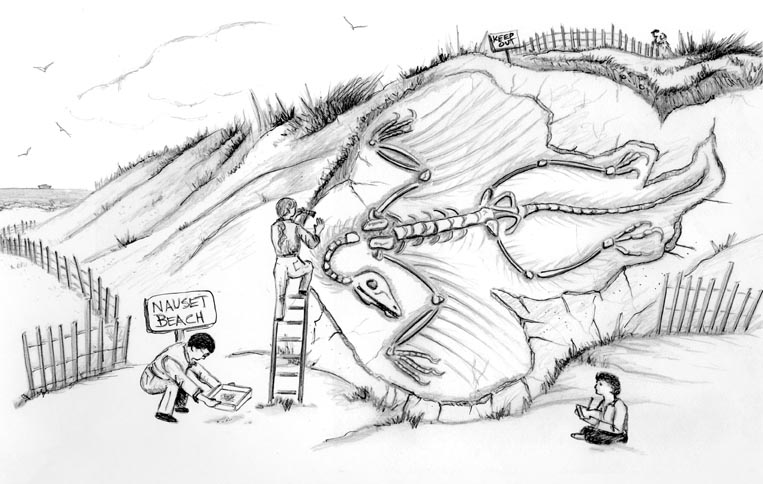
Dear Bird Folks,
Scientists seem to be convinced that birds are nothing more then flying dinosaurs. Unfortunately, everything I read on the subject is too technical for me and I didn’t understand much of it. I’m hoping you could explain this bird/dinosaur relationship. Also, much of the fresh interest in this topic is based upon a recent large fossil finding on Cape Cod. Do you know anything about this new discovery on Cape Cod?
– James, Plattsburgh, NY
I’m with you, James,
This dinosaur/bird connection is nearly impossible to understand. And when you think about it, who cares? I can’t even figure out which days the dump is open and I’m supposed to worry about something that happened fifty million years ago? But, alas, in light of the recent local discovery, I’ve been forced to learn far more about this topic than I ever thought I would. This leads me to another problem. I don’t know which is more upsetting to me – having to learn about dinosaurs or that I’m using the word “alas.”
I think most of us have an image of dinosaurs being these huge creatures that ran through ancient tropical forests knocking over trees and eating each other. The notion that something so large and ferocious is related to our pals the chickadees doesn’t seem right, no matter what kind of imagination you have. However, word on the street is that it’s true. It seems that back in 1861 some Germans, who were digging in a limestone quarry (probably looking for parts for an old Volkswagen Beetle), came across a 150 million-year-old fossil of a dinosaur that had bird-shaped feet, a feathered tail and feathered wings. Whoa! The creature, named “Archaeopteryx,” not only provided a link between present-day birds and dinosaurs, but it turned out to be a killer word to use in Scrabble.
Let’s now fast forward to the excitement that is brewing in our neck of the woods. The Cape is probably the last place anyone would look for dinosaur fossils, and with good reason. Dinosaurs were long gone by the time the glaciers created the area we now call Cape Cod. The sand, gravel and clay, which make up the Cape, were delivered here by the last glacier, known to the eggheads of the world as the Laurentide ice sheet. As this ice sheet moved south from Canada, it pushed tons of rocks and debris with it. When the glacier receded, it left behind all sorts of things it had carried down from up north. Much of what was deposited was of little interest to most people…until last month’s surprising discovery.
The same winter storm that exposed the framework of a 19th century ship in Wellfleet also exposed an archeological gem on Nauset Beach in Orleans. The waves of that January storm exposed a perfect fossil of a birdlike creature that once roamed North America during the Mesozoic Era, which was long before many of you were born.
Interestingly, this discovery was totally ignored for the first several weeks because if you looked at the fossil with the naked eye, it resembled a bunch of sticks buried in a bank of sand and clay, fossilized-clay to be exact. Then some guy from Chicago, who was taking pictures of his girlfriend, noticed a weird image in the reflection of her sunglasses. Upon returning to Chicago he e-mailed the pictures to the Orleans Department of Natural Resources. They, in turn, forwarded the picture to Woods Hole Oceanographic Institute, which is where Cape Cod keeps all of its smart people. Woods Hole sent a team, led by famed archeologist, Dr. A. J. Oke, to the site. Within an hour Dr. Oke confirmed that the January storm had exposed one of the largest flying dinosaurs ever discovered. This huge creature is known to paleontologists as “Gynormous larkosuros” and is thought to have been seventeen feet long, with a twenty-five foot wingspan. Suddenly, every ancient bone-freak in the world was headed to Orleans.
With such an important find it is understandable that the area has been closed-off to the public. As I type this, researchers are preparing to move the huge bank of fossilized clay, which has housed the fossilized Gynormous larkosuros for the past 185 million years. Where are they moving it to, you ask? To the British Museum, of course. Apparently, the Brits have offered the most money and have agreed to remove the giant fossil within the next few weeks so it won’t interfere with the summer beach crowd. Orleans hates to have anything inconvenience those people.
Bowing to local pressure the folks at the British Museum have agreed to allow one day for public viewing of this ancient wonder. They have announced that we will have a two-hour window to see this creature and take all the pictures we want, before they move it across the pond. Keep in mind that the fossil looks like a bunch of sticks unless it is seen as a reflection. So remember, you’ll need a mirror or you won’t understand what all the fuss is about.
The giant fossil is located just past the bathhouses at Nauset Beach in Orleans. The hours of public viewing will be 10:00 AM until 12:00 noon, this Tuesday, April 1st. Don’t forget your camera and mirror.